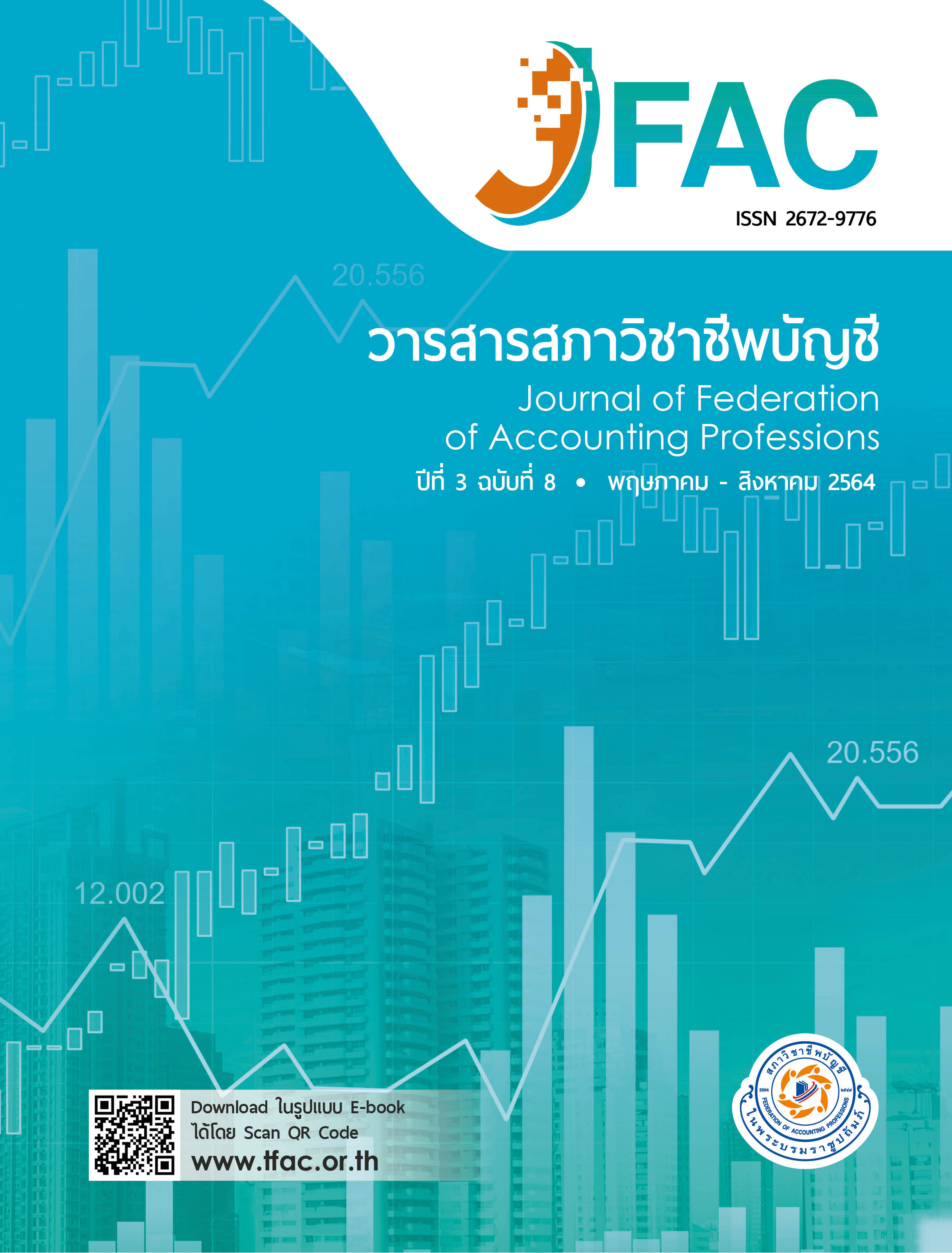คุณภาพการควบคุมภายในด้านเทคโนโลยีสารสนเทศตามกรอบโคบิทของสถาบันอุดมศึกษาในประเทศไทย
Main Article Content
บทคัดย่อ
การวิจัยครั้งนี้มีวัตถุประสงค์เพื่อ (1) ประเมินผลการควบคุมภายในด้านเทคโนโลยีสารสนเทศของโคบิทของสถาบันการอุดมศึกษาในประเทศไทย (2) ศึกษาผลกระทบของการการควบคุมภายในด้านเทคโนโลยีสารสนเทศของโคบิทที่มีต่อคุณภาพการควบคุมภายในตามมาตรฐานสากล กลุ่มตัวอย่าง คือ หัวหน้างานการเงินหรือบัญชีที่ปฏิบัติงานของสถาบันการอุดมศึกษาในประเทศไทย จำนวน 175 คน ใช้การสุ่มตัวอย่างแบบชั้นภูมิ เก็บรวบรวมข้อมูลโดยใช้แบบสอบถาม สถิติที่ใช้ในการวิเคราะห์ ได้แก่ ค่าความถี่ ค่าร้อยละ ค่าเฉลี่ย ส่วนเบี่ยงเบนมาตรฐาน การวิเคราะห์สหสัมพันธ์ และการวิเคราะห์ถดถอยพหุคูณ ผลการศึกษาเรื่องการประเมินผลการควบคุมภายในด้านเทคโนโลยีสารสนเทศตามแนวทางของโคบิทของสถาบันการอุดมศึกษาในประเทศไทย พบว่ามีระบบการควบคุมภายในด้านเทคโนโลยีสารสนเทศตามกรอบโคบิทในภาพรวมที่ดี ผลจากการวิเคราะห์ถดถอยพหุคูณพบว่าปัจจัยที่มีผลกระทบต่อคุณภาพการควบคุมภายใน ได้แก่ ปัจจัยด้านการวางแผนและจัดองค์กร ด้านจัดหาและนำระบบใช้จริง และด้านการติดตามและประเมินผลที่ระดับนัยสำคัญทางสถิติ 0.05 แสดงให้เห็นว่าการควบคุมภายในด้านเทคโนโลยีสารสนเทศช่วยเสริมการควบคุมภายในตามกรอบมาตรฐานสากล มีการวางแผนงานด้านเทคโนโลยีสารสนเทศที่สอดคล้องกับแผนกลยุทธ์องค์กร สามารถจัดการความเสี่ยงทางด้านเทคโนโลยีสารสนเทศที่อาจเกิดขึ้น รวมทั้งการส่งมอบระบบงาน ที่เป็นไปตามความต้องการของผู้ใช้งานจะช่วยทำให้เกิดการทำงานที่มีประสิทธิภาพประสิทธิผล ช่วยสร้างมูลค่าเพิ่มและศักยภาพทางการแข่งขัน รวมทั้งมีสารสนเทศที่มีคุณภาพเพื่อใช้ในการบริหารงานและติดตามประเมินผลงาน สามารถตรวจพบและแก้ปัญหาต่าง ๆ ได้ทันกาล
Article Details
เนื้อหาและข้อมูลในบทความที่ลงตีพิมพ์ในวารสารสภาวิชาชีพบัญชี ถือเป็นข้อคิดเห็นและความรับผิดชอบของผู้เขียนบทความโดยตรงซึ่งกองบรรณาธิการวารสารไม่จำเป็นต้องเห็นด้วยหรือร่วมรับผิดชอบใด ๆ
บทความ ข้อมูล เนื้อหา รูปภาพ ฯลฯ ที่ได้รับการตีพิมพ์ในวารสารสภาวิชาชีพบัญชี ถือเป็นลิขสิทธิ์ของวารสารสภาวิชาชีพบัญชี หากบุคคลหรือหน่วยงานใดต้องการนำข้อมูลทั้งหมดหรือบางส่วนไปเผยแพร่ต่อหรือเพื่อกระทำการใดๆ จะต้องได้รับอนุญาตเป็นลายลักษณ์อักษรจากวารสารสภาวิชาชีพบัญชี ก่อนเท่านั้น
เอกสารอ้างอิง
ภาษาไทย
กัญฐณา ดิษฐ์แก้ว. (2558). ปัจจัยเชิงสาเหตุที่มีผลต่อการใช้ดุลยพินิจในการวางแผนสอบบัญชีและส่งผลไปยังคุณภาพการสอบบัญชี: การวิจัยเชิงประจักษ์ในบริบทผู้สอบบัญชีรับอนุญาตในประเทศไทย. วารสารการบัญชีและการจัดการ, 7(2), 185-200.
กิตติพงษ์ โภชนะสมบัติ. (2557). การประเมินผลระบบควบคุมภายในตามแนวคิด COSO กรณีศึกษา หน่วยงานในสังกัดสานักงานปลัด
กระทรวงการคลัง. (2561). หลักเกณฑ์กระทรวงการคลังว่าด้วยมาตรฐานและหลักเกณฑ์ปฏิบัติการควบคุมภายในสำหรับหน่วยงานของรัฐพ.ศ.2561. กรุงเทพฯ: กระทรวงการคลัง.
ชลิต วณิชยานันต์. (2558). การศึกษารูปแบบการบริหารจัดการไอซีทีโดยใช้หลักการโคบิทสำหรับมหาวิทยาลัยราชภัฏ. วารสาร Veridian E-Journal สาขาวิทยาศาสตร์และเทคโนโลยี, 2(1), 13-31.
ธนพร ชูจิตต์ประชิต, อรสา อร่ามรัตน์ และสันสกฤต วิจิตรเลขการ. (2550). ปัจจัยที่มีผลต่อระดับการควบคุมภายใยระบบสารสนเทศภายใต้ระบบการบริหารการเงินการคลังภาครัฐของหน่วยงานราชการ. วารสารเกษตรศาสตร์ธุรกิจประยุกต์, 1(1), 54-61.
ธนพล นามนวล และปรัชญนันท์ นิลสุข. (2562). การกำกับดูแลที่ดีด้านเทคโนโลยีสารสนเทศในสถาบันอุดมศึกษาตามกรอบปฏิบัติ COBIT. วารสารมนุษยศาสตร์และสังคมศาสตร์ มหาวิทยาลัยธนบุรี ,13(3),169-180.
รัชนิดา โสมะ และจีราภรณ์ พงศ์พันธ์พัฒนะ (2560). กลยุทธ์การตรวจสอบในที่ส่งผลต่อประสิทธิภาพการดำเนินงานของมหาวิทยาลัยในสังกัดสำนักงานคณะกรรมการอุดมศึกษา. วารสารมนุษยศาสตร์และสังคมศาสตร์ บัณฑิตวิทยาลัย มหาวิทยาลัยราชภัฏพิบูลสงคราม, 11(2), 162-173.
อุษณา ภัทรมนตรี. (2563). การตรวจสอบภายในสมัยใหม่. กรุงเทพฯ :โรงพิมพ์ มหาวิทยาลัยธรรมศาสตร์.
ภาษาอังกฤษ
Aaker, D. A., Kumar, V., & Day, G. S. (2013). Marketing research. (13th ed.). Hoboken, New York: John Wiley & Sons.
Abbott, L., Park, Y., & Parker, S. (2000). The effects of audit committee activity and independence on corporate fraud. Managerial Finance, 26(11), 55–67.
Afiah, N. N., & Azwari, P. C. (2015). The effect of the implementation of Government Internal Control (GICS) on the quality of financial reporting of the local government and its impact on the principle of good governance: A research in district, city and provincial government in South Sumatera. Procedia-Social and Behavioral Sciences, 211(2015), 811-818.
Azhar Susanto. (2015). What factors influence the quality of accounting information?. International Journal of Applied Business and Economic, 13(6), 3995 – 4014.
Barney, J. (1991). Firm resources and sustained competitive advantage. Journal of Management, 17(1), 99-120.
Biddle, G., Hilary, G., & Verdi, R. S. (2009). How does financial reporting quality relate to investments efficiency?. Journal of Accounting and Economics, 48, 112–131.
Black, K. (2019). Business statistics for contemporary decision making. (10th ed.). New York: John Wiley & Sons.
Carcello, J., Hermanson, D., & Raghunandan, K. (2005). Factors associated with US public companies’ investment in internal auditing. Accounting Horizons, 19(2), 65-80.
Chang, Yu-Tzu, Chen, H., Cheng, R. K., & Chi, W. (2019). The impact of internal audit attributes on the effectiveness of internal control over operations and compliance. Journal of Contemporary Accounting & Economics, 15(2019), 1-19.
Chong, H. C., Ramayah, T., & Subramaniam, C. (2018). The relationship between critical success factors, internal control and safety performance in the Malaysian manufacturing sector. Safety Science, 104, 179-188.
Committee of Sponsoring Organizations of the Treadway Commission (COSO). (2013). Internal control—Integrated Framework. Exposure Draft, Retrieved 25 September 2020. From http://www.ic.coso.org
Cronbach, l. J. (1951). Coefficient alpha and the internal structure of tests. Psychometrika, 16, 297-334.
Curtis, M. B., & Wu, F. H. (2000). The component of a comprehensive framework of internal control. The CPA Journal, 70(3), 64.
Ditkaew, K. (2018). The effect of cost management quality on the effectiveness of internal control and reliable decision-making: Evidence from Thai industrial Firms. Advance in Social Education and Humanities Research, 211, 10th International RAIS Conference on Social Sciences and Humanities (RAIS 2018), 60-69.
Ege, M. S. (2015). Does internal audit function quality deter management misconduct?. Accounting Review, 90(2), 495–527.
Hair, Jr. J. F., Black, B. B., Babin, B. J. & Anderson, R. E. (2010). Multivariate data analysis: A global perspective. (7th ed). New Jersey: Pearson Printice Hall.
Jonas, G., & Diamanto, P. (2006). Board Control and Corporate Innovation: An Empirical Study of Small Technology- Based Firms. Centre for Innovation, 1-28.
Leinicke, L. M., Ostrosky, J. A., & Rexroad, W. M. (2000). Quality Financial Reporting: Back To The Basics. The CPA Journal, 70(8), 69-71.
Lender, G. H., & Auger, K. A. (2008). The need for transparency in financial reporting: Implications of off-balance-sheet financial and inferences for the future. Journal of Accounting & Organization Change, 4(1), 27-46.
Lin, S., Pizzini, M., Vargus, M., & Bardhan, I. R. (2011). The role of the internal audit function in the disclosure of material weaknesses. Accounting Review, 86(1), 287–323.
Mahmudi. (2011). Akuntansi Sektor Publik. UII Press: Yogyakarta.
Nunnally, J.C. & Bernstein, I.H. (1994). The Assessment of Reliability. Psychometric Theory, 3, 248-292.
Prawitt, D. F., Smith, J.L., & Wood, D.A. (2009). Internal audit quality and earnings management. Accounting Review, 84(4), 1255–1280.
Wade, M., & Hulland, J. (2004). The resource-based view and information system research: Review, extension, and suggestions for future research. MIS Quarterly, 28(1), 107-142.
Wittayapoom, K. (2014). New Product Development, Accounting Information, and Internal Audits: A Proposed Integrative Framework. Social and Behavioral Sciences, 148, 307-314.


